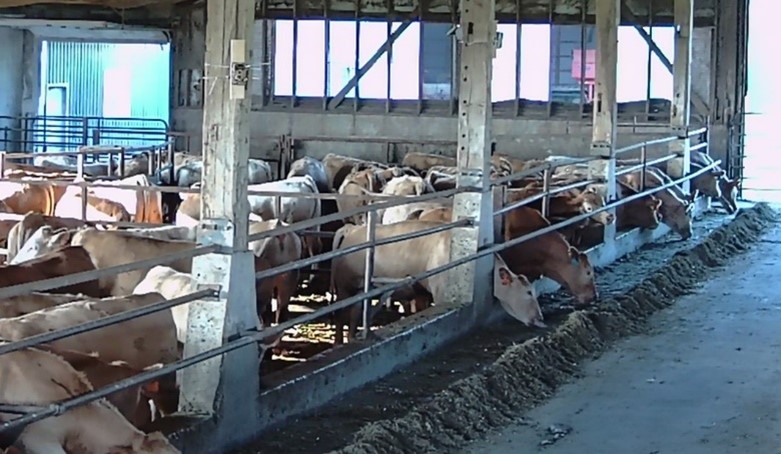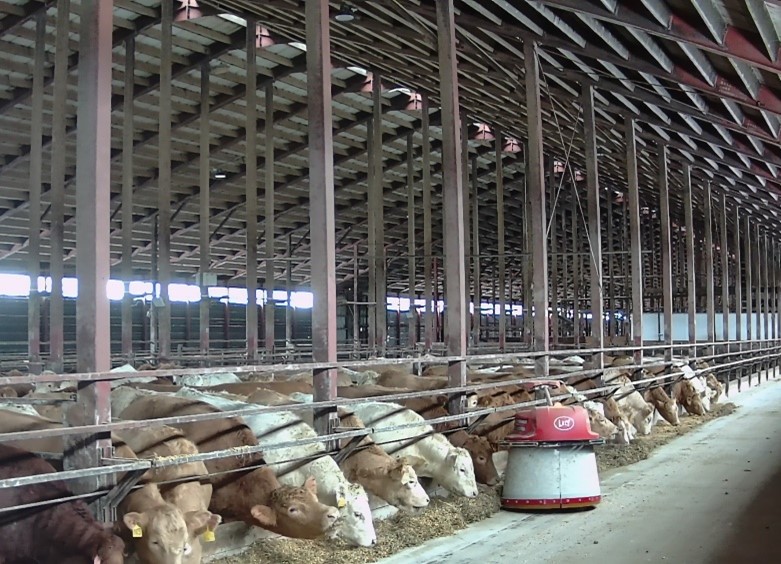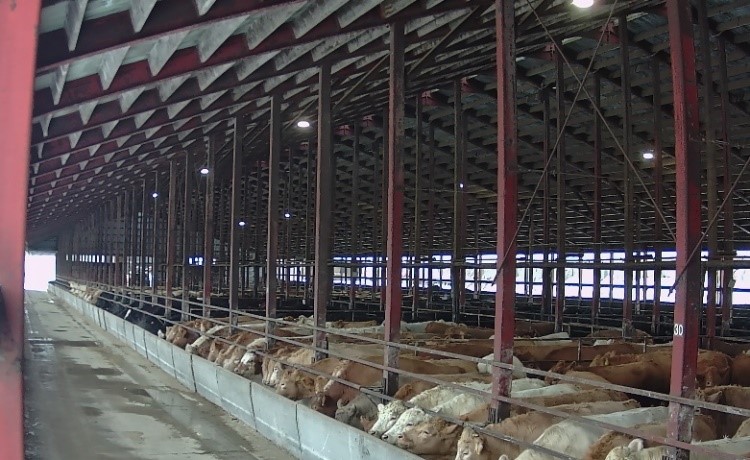By Sedley Benitz, OMAFRA Beef Sustainability Assistant and Christoph Wand, OMAFRA Livestock Sustainability Specialist
Several recent projects have been conducted to improve bunk management practices in Ontario feedlots. In the summer of 2020, a collaborative project to evaluate bunk management strategies at various farms was launched by the Ontario Corn Fed Beef Program, and the Ontario Ministry of Agriculture, Food, and Rural Affairs. Bunk management strategies were identified using trail cameras installed in a number of feedlot barns. Slick bunk management is an important practice to reduce feed waste by allowing the bunks to be empty for only an hour or less. The 2020 project found that bunks were often left empty for longer than an hour with the average length of time being 5.5 hours. This long period of time without access to feed can cause digestive issues and performance problems for cattle. Notably, the trail cams found that there was an increased response from the cattle during feeding times and feed push-ups, meaning that cattle are more likely to visit the bunk directly after or during feeding or push-ups. In the summer of 2021, bunk management strategies were evaluated for newly received cattle, a critical period for cattle health that can impact future performance. Through this study, the importance of consistent feeding times and feed availability was shown to be crucial for achieving maximum gains and should be a focus on feedlots.
The importance of proper bunk management cannot be over-emphasized. Having consistent feeding times and frequent push-ups allows for the cattle to have a more consistent feed intake throughout the day and night, reducing stress, therefore, improving overall performance. Ensuring that there is enough feed available for cattle when the feedlot operator is away from the barn can be accomplished by ‘reading’ the bunk consistently prior to feeding and every time people are in the barn. By ‘reading’ the bunk consistently, a score from 0-4 will be given, with 0 being an empty bunk and 4 being full and mostly untouched feed (Rusche, 2020). This can be done by looking at the bunks at each individual pen and assigning a number based on the amount of feed left at the bunk. This will indicate if more or less feed should be provided to the cattle.
Feed pushers are a common technology used in the dairy industry that helps promote consistent feeding behaviour and feed intake. They reduce labor by eliminating manual push-ups and allow for push-ups, even when the farmer is away from the barn. In the beef industry, manual push-ups are commonly performed multiple times a day on farms with flat bunks (tables) but are not needed with J bunks. As seen in figure 1, a significant amount of feed can be out of reach of cattle within a few hours of feeding time. Feed pushers automatically move through the barn pushing feed towards the cattle that would otherwise be out of reach as shown in in figure 2. Improving the consistency of feed intake can improve performance by reducing the risk of digestive disorders such as bloat, acidosis, and liver abscesses.


Beginning in the summer of 2021 feed pushers were installed to evaluate them as an add-on to existing bunk management strategies at two sites. Each site had similar technology installed by two different manufacturers. The feed pushers were used on pens with flat bunks (Figures 1 and 2). Prior to the installation of this technology, the feed was pushed up throughout the day manually or by a vehicle-mounted blade. Trail cameras were used to determine feeding behaviour before and after the machines were installed to determine if this technology had the ability to encourage more frequent bunk visits and consequently increase cattle feed intake. At site A, feeding behaviour, and intake were compared between three different bunk management styles: J bunks (Figure 3), flat bunks (tables) with push-ups being conducted by the automated feed pusher, and flat bunks with push-ups conducted using a blade mounted on a skid steer. Newly received cattle were split between one of three treatment groups. The results of these three treatments are currently being evaluated.

In the summer of 2022, the cost of a feed pusher was compared to manually pushing up feed and the installation of a J-bunk (Table 1). This partial budget was done for a theoretical 1000 head barn based on known capital, operational, and labour costs. The construction cost was highest for the J-bunk compared to the flat bunk, however, on long-term operational cost, it was the cheapest alternative of the three. Labour was included to an extent, but more information will need to be provided to make an accurate comparison between the three bunk management approaches. J-bunks have been a staple in the feedlot industry for years, but labour considerations and the possibility of managing feeding behaviour might make a feed pusher enticing for producers.
Table 1. Cost comparison of bunk type and push-up methods including capital costs (construction over 20 years, or purchase over 10 years) and operational (labour, energy, repair per year) represented as total cost per steer per year in a 1000 head barn.
| Bunk type | Construction + purchase cost | Annual operational cost | Cost per steer space per year |
| J-Bunk | $23,438.00 | $782.14 | $2.02 |
| Flat bunk with automated push ups | $27,198.00 | $1,220.14 | $4.34 |
| Flat bunk with skid steer (used) push ups | $29,995.00 | $1,316.66 | $4.73 |
Producers typically do not have the ability to view the bunk overnight resulting in uncertainty regarding the length of time the bunk is left empty by morning. The inclusion of a trail camera will be evaluated as a tool to allow producers to read their bunk throughout the night. This will help producers determine if the amount of feed being offered is enough to keep the bunk full until one hour prior to feeding to ensure proper slick bunk management.
Feed pushers may be a valuable technology for producers, allowing them to reduce labour and ensure consistent feed intake throughout the day and night for cattle. Through data collected from this project and past projects, it was determined that producers are often not aware of the amount of time the bunk is left empty at night. The use of a feed pusher can be helpful to many producers provided enough feed is available to the cattle for a full 23-hour period to encourage proper slick bunk management.
Rusche, W. (2020). Feed Bunk Management. South Dakota State University Extension.
Lundy, E., Loy, D., and Dahlke, G. (2015). Iowa Beef Center: Feed Bunk Management. Iowa State University Extension and Outreach.
